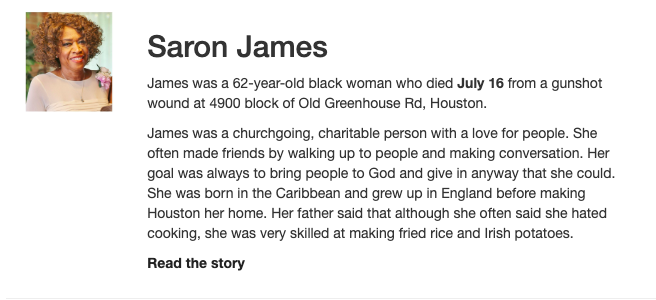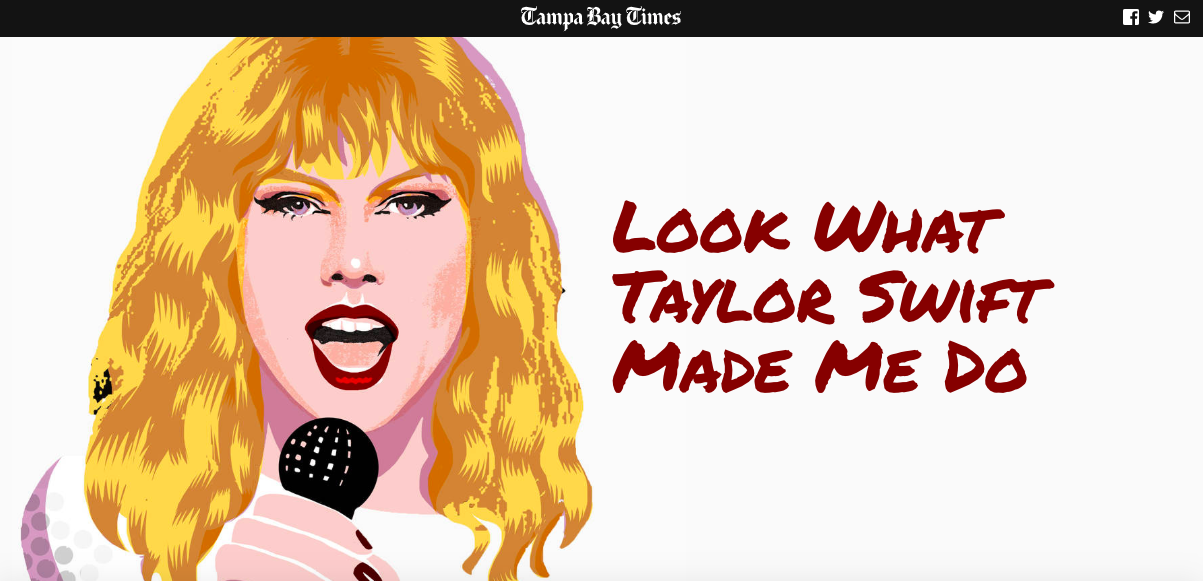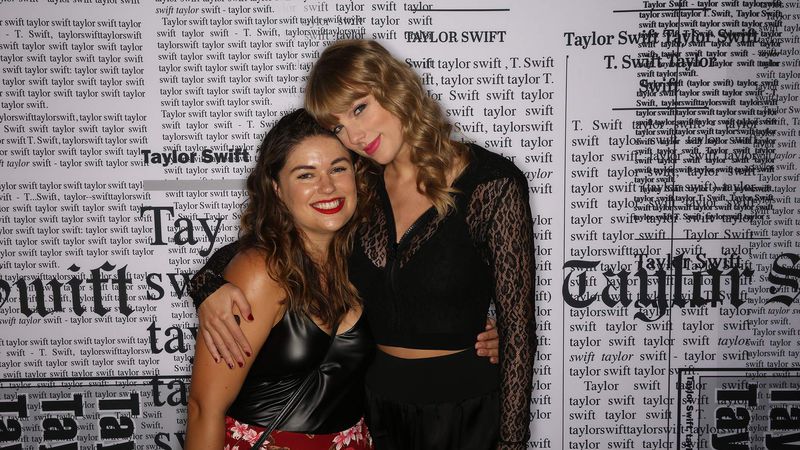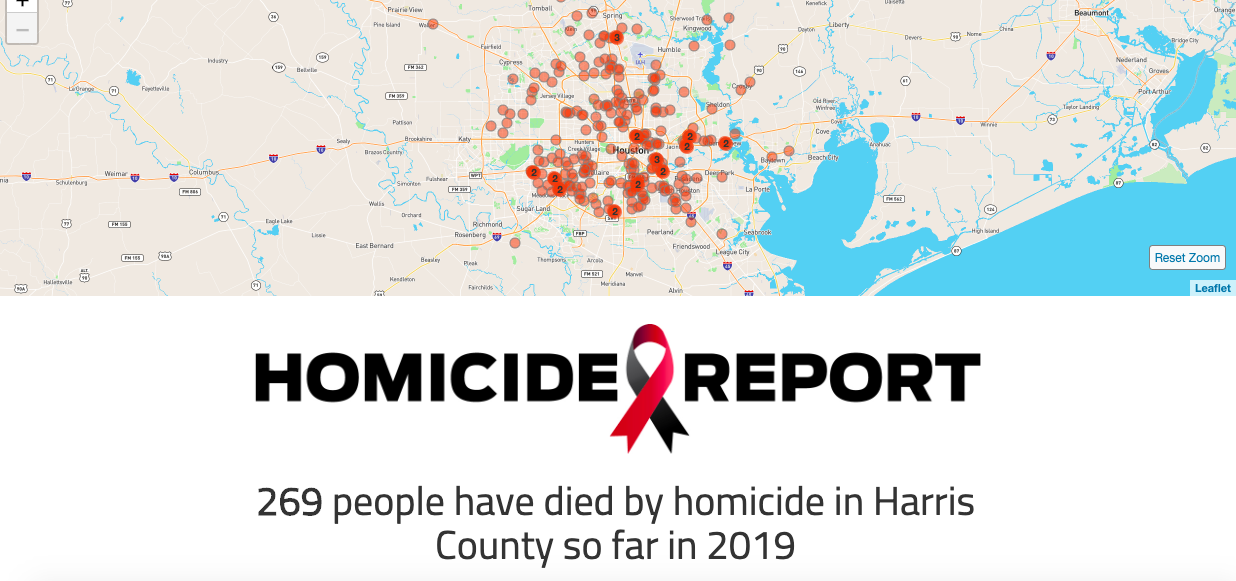Nearly every newsroom has to cover homicides, “but they happen in big numbers in big cities,” said Matt Dempsey, data editor of the Houston Chronicle. “As newsrooms have gotten smaller, we’ve reduced our coverage of them to breaking news.”
But several newsrooms, including the Los Angeles Times, the Baltimore Sun and the Palm Beach Post have started to pull the lens back to look at the stories and people behind the breaking news and what the numbers say about what’s happening.
When the Houston Chronicle’s data team and digital staff teamed up, they created a Homicide Report. The project includes the names and available data on homicide victims and stories about them from family members.
You can read about the power of data and story from Houston this week, and, in a very different kind of data-driven project, from the Tampa Bay Times (which Poynter owns).
Related: Want more on local news? Sign up for our weekly newsletter, Local Edition
What’s your newsroom working on? Share the work that you’re proud of, and I’ll reach out if we decide to feature it.
All the answers shared here came through a Google form and answers have been edited for length and clarity.
“Our goal was to take something they might have been doing already and add a data layer to it so we could find additional stories and elevate our coverage in new ways.” Matt Dempsey, Houston Chronicle
Newsroom: Houston Chronicle
Newsroom size: 250
Project: Homicide Report
How did you make this story/series happen?
Toward the end of 2018, the Chronicle data team was looking for ways to team up with our digital staff. Our goal was to take something they might have been doing already and add a data layer to it so we could find additional stories and elevate our coverage in new ways.
One of our suggestions was a homicide report. The LA Times had started one years ago and I really liked how it took something that was typically treated as breaking news and made it more considered and thoughtful. I also liked how it created data that could be used to tell different stories on the subject.
I pitched it to digital and they loved it; they requested a month’s worth of homicides in February from the local medical examiner’s office and used that as a trial case.
We concluded that we could do this but wanted to make sure it was sustainable. We ended up requesting new data every month, while working on the site that would host it. About three months in, we realized we would need next-of-kin contact information to flesh out the stories of the victims beyond the statistics.
In the final push, we had five journalists calling the family members of almost 300 homicide victims through July of 2019.

Screen shot, Houston Chronicle
What did you learn from the process?
The response from this project shows it matters to the community. People intrinsically know that homicide victims deserve more than what we’ve given them in the past.
The side benefit for any newsroom that wants to do something like this is that there are many enterprise stories lurking in those numbers and in the stories we hear from the loved ones of victims.
Related training: Investigative training – From numbers to narrative
How can other local newsrooms do work like this?
Be realistic about the time commitment. You need to have a data set you can rely on that you can get easy access to on a regular basis. You need to commit to reaching out to every victim’s family, even knowing you won’t hear back from everyone. Otherwise, the whole enterprise will feel exploitative.
Have a plan for photos. Do you have an outside source for photos? Our backup photos come from the state department that handles driver’s licenses. But we also ask every family for a photo they’d like to share.
Have a vision for how you’re going to handle victim stories, the statistics of homicide and how you’re going to find the stories hiding in the data/victim stories.
Who worked on this?
Jordan Rubio, Stephanie Lamm, Matt Dempsey, Danny Hermosillo, Jay Jordan, Julian Gill, Dana Burke, Jasmine Goldband, Natalie Weber, Natalie Webster
“Nothing is more critical to a news organization than reporters who are actually going out and talking to others, getting to know the community and informing the public of important topics.” Tara McCarty, Tampa Bay Times
Newsroom: Tampa Bay Times
Newsroom size: About 150
Project: “Look What Taylor Swift Made Me Do,” and a follow-up after “Lover” was released
How did you make this project happen?
This story came from my own weird brain wanting to see something visualized and since I work at a newspaper, I turned to my colleagues to help. I struggled to set the analysis in motion for a couple years before finally got the timing down. I got with both the data/investigations editor Adam Playford and the features editor Stephanie Hayes to figure out the how and the why. As I counted lyrics first in software created for analyzing government documents and then in a google doc, the data team crunched some of the numbers through program scripts. From that information, I could chart how often Taylor Swift used certain words (like dream or red) across her catalog of music, including the past and present tenses she used to analyze things like how often she appeared nostalgic. And honestly, that was the easy part. Because being honest with myself to get to the why of the story was the hardest. Hayes probed about why this was important for me to do and why it might be important for others to read. In the end, I told my story of growing up with Taylor Swift and matched it with what her lyrics said about her own experiences. As Lane DeGregory pointed out in her recent podcast interview with me, while it may not have been hard-hitting news, it also served as a snapshot of what it looked like to grow up during the 2000s. I also worked closely with the web team and social team to try and infiltrate the internet with the project.
Related: How the Tampa Bay Times took on a complicated story with simple storytelling (and Legos)
Knowing her fanbase and where she tends to reach them, I knew it would be important to push it as much as possible to get them to read it. It would only take the right person before it could spread like wildfire. I worked mostly outside of my regular job as a page designer to get this done in time for her concert in Tampa in 2018.
After the story ran online and in print, as the follow-up story explains, Taylor Swift read it and I was invited to meet her. The funny thing is that despite all my efforts to push the project online, she read it in print when she came to town.
A year later, upon the midnight release of her seventh album, Lover, I sat up until 4:30 a.m. listening, tallying, making connections and writing a quick follow up story of my notes. I didn’t delve into the why so much in the most recent addition because of the time crunch. But I feel like there’s an endless amount of deductions that can be made from her lyrics. Even though the project is done, the work is never finished.

Illustration by Delphine Lee, Special to the Times
What did you learn from the process?
I learned a lot from the project — almost all lessons for myself. Probably the most important takeaway to me is that, while this was a passion project and I’m deeply grateful for all the help I had with it, nothing is more critical to a news organization than reporters who are actually going out and talking to others, getting to know the community and informing the public of important topics. As I was racing toward the finish line for this project, the same team helping me with the data was actually working on a story about lead found in Hillsborough County school drinking fountains. That had infinite ways of being more impactful and more important for our community than anything I was discovering through a lyrics analysis. I felt horrible for dividing their attention in any capacity and after publication had a newfound respect for the journalists I work with.

Times staffer Tara McCarty was invited to meet Taylor Swift before the Reputation Stadium Tour at Raymond James Stadium on Aug. 14, 2018 after Tara wrote an article analyzing Taylor’s lyrics. Courtesy of Premium PR.
How can other local newsrooms do work like this?
If anyone in job X thinks they want to try their hand at job Y, then I think all it takes is the right pitch and the right support. Even if it takes several years, the payoff could be huge. That doesn’t mean meeting Taylor Swift, but success looks different to everyone. I never imagined that she’d actually read it. If I’d given up after the first or second attempt … I mean, you never know what your capabilities or opportunities will be until you go for it. And it helps to have people supporting you.
Related training: How to cover the arts on any beat
Who worked on this?
Tara McCarty, Stephanie Hayes, Adam Playford, Jay Cridlin, Gabrielle Calise, Danese Kenon, Dirk Shadd, James Borchuck, Eve Edelheit, Eli Murray, Brittany Volk, Eli Zhang, Neil Bedi, Becca Guajardo, Paul Alexander and Martin Frobisher.
Kristen Hare covers local news for Poynter. She can be reached at khare@poynter.org or on Twitter at @kristenhare.







